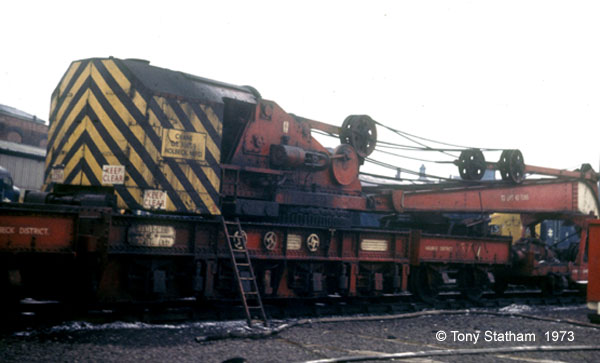
Historical Background
Steam Power replaced by Diesel
Given the difficulties in the provision of coal and water on what had become a predominantly diesel and, to an extent, electric railway system, the steam breakdown cranes did well to hold their own for so long. Paradoxically, the conversion to diesel-hydraulic of the steam powered ‘Modernisation Plan’ 75-ton cranes in the late 1970s aided the preservation of some of the older and smaller steam powered cranes…
All ten steam powered 75-ton ‘Modernisation Plan’ cranes were converted to diesel-hydraulic operation between 1976 and 1978, the conversions being carried out at Derby Locomotive Works to the designs of the British Railways Board. Just four of the ten remain extant, ADRC96706 having been scrapped from Churnet Valley Railway in September 2010.

Cowans Sheldon 75-ton crane ADRC96703 awaits admittance into Derby Works on
18th December 1976 for conversion from steam to diesel-hydraulic
The eight steam powered 30-ton sister cranes were poorly suited to breakdown work and none were converted. The Southern’s two 30-ton diesel-mechanical cranes were equally unsuited to heavy loco recovery but all ten continued in use for other purposes.
It is of interest that 30-ton diesel-mechanical crane ADRC96100, the very first diesel powered breakdown crane to go into service on the British railway system, now remains the sole representative of the diesel-mechanical cranes following the scrapping in March 2008 of its twin ADRC96101 (which appeared to have been in remarkably good condition shortly prior to that event).

Cowans Sheldon 30-ton diesel-mechanical crane ADRC96100 at Carnforth, March 2008
Of the original population of ten ‘Modernisation Plan’ 30-tonners, six were extant in early 2009. However the two which had been sold in 1973 to CIE (Ireland) and re-gauged were scrapped in 2009 and the Severn Valley Railway's RS1091/30 was scrapped in 2010. The SVR has another of the 30-tonners, RS1087/30, which is maintained in working order.

Cowans Sheldon 30-ton steam crane RS1087/30 in preservation at Bridgnorth on the
Severn Valley Railway
The conversion of the 75-ton breakdown cranes from steam to diesel almost certainly aided the preservation of some of the older steam cranes which, rather than being scrapped immediately upon withdrawal from their normal duties, found a new life as stand-ins for 75-tonners going to Derby for conversion. A good example is the 1931 Ransomes & Rapier 36/40-ton breakdown crane ADRR95207 which spent most of its working life at Leeds Holbeck. This crane became surplus when Holbeck ceased as a breakdown recovery centre in 1978 and was moved to Doncaster where it became the stand-in for Doncaster's 75-ton steam crane ADRC96709 whilst the latter was in Derby Works for conversion from steam to diesel-hydraulic power. If such a purpose had not been found for the deposed Holbeck crane it would almost certainly have been scrapped.

ADRR95207 at Leeds Holbeck in c.1973, some five years before standing in at Doncaster whilst their ADRC96709 was at Derby for conversion from steam to diesel-hydraulic
ADRR95207 was maintained in working order as a stand-by at Doncaster until the very end of 1982, the 75-ton steam to diesel conversions being unreliable in their early days. It is known, for example, that the converted 75-tonner received by Stratford in 1977 (ex-Carlisle Kingmoor ADRC96704) gave a lot of trouble and was twice returned to Derby over a period of twelve months for correction. Stratford were so concerned about the unreliability of the 75-tonner that they declined for a while to hand back the old 45-ton steam crane which had been provided to cover during the conversion. Stratford’s concern is understandable when one realises that their breakdown train was being called out some 300 times in a year, not only to attend to their own patch, which included the massive Temple Mills marshalling yard, but often to assist other depots.
The era of the steam powered breakdown crane on the British railway system, which had started with the Appleby Bros 5-tonners in 1875, came to an end with the conversion between 1985 and 1988 of five of the wartime-built Cowans Sheldon 45-tonners from steam to diesel-hydraulic. BR disposed of these only seven or eight years later, just two of them reaching preservation and now situated at Llangollen Railway and Crewe Heritage Centre.
The example now at Llangollen Railway performed, as its last regular duty, engine/generator changes for the Class 50 locomotive fleet at Plymouth Laira depot and when the last of the Class 50 was withdrawn this crane became surplus to requirements and was withdrawn also.
The last steam-powered breakdown cranes owned by BR were the first two wartime cranes supplied by Ransomes & Rapier to the Southern Railway as numbers 1560S and 1561S, these being sold into private hands in June 1989. So far as can be determined, a preserved steam breakdown crane (the remarkable GWR No. 2 of 1908) actually made the last ever steam-powered lift on BR metals as late as August 1989.
